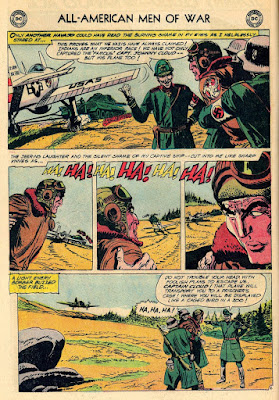The vast majority of DC war comics of the Silver Age-- which I, as a non-expert, perceive to be the heyday of the company's execution of the genre-- tend to be fairly straightforward "gotta out-tough the enemy" potboilers. Robert Kanigher produced tons of these by-the-numbers combat-capers< But as with his superhero and western works, on occasion he came up with something in a mythic mode. In "The Killer Slot," he sought to work in his (undoubtedly simplified) comprehension of Amerindian psychology into just such a "tough it out" scenario.
"The Killer Slot"-- which is a pilot's name for a zone in which one plane has another at a disadvantage-- begins in media res. WWII "Navajo Ace" Johnny Cloud has been forced to land by another ace, one Von Kleit, Grinning goosesteppers take him prisoner, and for good measure mock him for being a Red Man:
Naturally, Cloud breaks free without getting immediately shot dead. Yet, rather than being, like most protagonists, solely concerned with his mission, Cloud becomes morose for having brought shame on his warrior heritage. This conveniently reminds him of an incident in his youth on the reservation, wherein he and his girlfriend rescued a falcon from a marauding hawk. This whole situation takes place near the cave of local shaman-type "Smoke-Maker," and that's where Cloud and his girlfriend take the smaller bird, believing that the falcon is dead. Smoke-Maker claims that even dead birds cannot rest without taking a last strike at an enemy. Providentially, the falcon seems to come to life, at least long enough to attack the hawk, after which both are joined in death.
This doesn't exactly sound like a good omen for the hero of a continuing serial. Having finished this segue into the distant past, Cloud finally fills in the reader on the dogfight that led to his current situation. After shooting down some enemy planes, Cloud sees a lone American soldier on the ground, being menaced by a German tank. Cloud rescues the grunt, with the amusing thought that the tank-gun reminds him of "a cowboy with a six-shooter." Naturally, this time the "Indian" wins.
However, Cloud's heroic action leaves him open to his plane being forced down by two German fighters, and thus we return the reader to the present time. Cloud wanders around a while, moping about being shamed because he didn't manage to strike back against the enemy, and then finds the soldier he saved. The unnamed fellow expresses his shame for having failed his own martial attempts, at which point Cloud realizes that white people also feel the same shame as Indians over failure, which presumably soothed the egos of the readership.
The soldier, even in his wounded condition, helps Cloud regain his downed airplane. As the Navajo Ace takes off, he only has a split second to shoot down the enemy ace Von Kleit (never actually seen on-panel) before he Cloud falls victim to the Killer Slot. Probably no readers were surprised when Cloud, in taking down his enemy, did not suffer the fate of the dead falcon. But even if "Killer Slot"-- graced with somke really nice aviation-art by Irv Novick-- doesn't transcend the formula of the "tough-guy war-hero," Kanigher did somewhat better here in melding the psychology of shame with the imagined warrior code of a Native American hero.
The Spirit Archives Volume Twenty-Four!
57 minutes ago





No comments:
Post a Comment